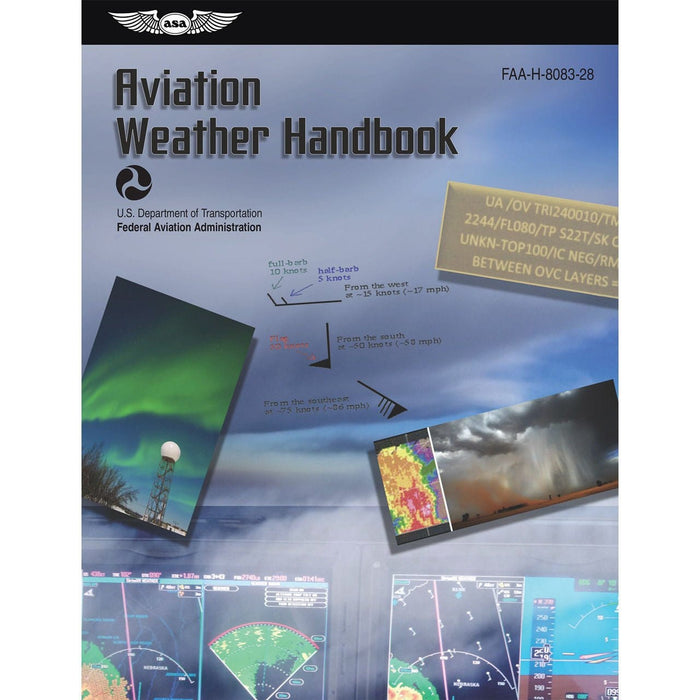AWOS vs ASOS: What You Should Know
You are planning your flight and need to check surface weather conditions at your destination airport. But which system do you use? AWOS? ASOS? What is the difference between the two and how do you know which system an airport is using?

Featured Pilot Gear
Browse our selection of high-quality pilot supplies! Your purchase directly supports our small business and helps us continue sharing valuable aviation content.
You are planning your flight and need to check surface weather conditions at your destination airport. But which system do you use? AWOS? ASOS? What is the difference between the two and how do you know which system an airport is using?
Both AWOS and ASOS are types of automated surface weather observation stations. They report conditions in the immediate vicinity of the airport and are a vital part of aviation weather reporting.
At larger towered airports, you may see a human-monitored Automated Terminal Information Service (ATIS) issuing reports rather than AWOS or ASOS. If the towered airport is not towered 24-hours a day, the weather reporting will revert from ATIS to either AWOS or ASOS while the tower is closed.
The main differences between AWOS and ASOS are the frequency of the reports, the content and additional features of the reports, and the agency responsible for doing the reporting.
(Visit: The FAA's Surface Weather Observation Stations (ASOS/AWOS) )
Automated Weather Observing System (AWOS)
The Automated Weather Observing System (AWOS) is controlled and operated by the FAA. New twenty to thirty-second weather reports are generated and transmitted on a minutely basis making AWOS weather data virtually real-time. The AWOS system was the original aviation weather reporting system and AWOS stations are located solely at airports.
Levels of AWOS
There are nine levels of AWOS reporting, and each level provides different amounts and types of weather data. The level of AWOS in a given location is determined by the type of sensors the weather station is equipped with. Most airports will have some variant of a level III AWOS station.
- AWOS A: Altimeter setting only
- AWOS A/V: Altimeter and visibility
- AWOS I: altimeter, density altitude, dew point, temperature, and wind data
- AWOS II: AWOS I data plus visibility
- AWOS III: AWOS II data plus cloud/ceiling
- AWOS IIIP: AWOS III data plus precipitation type identification
- AWOS IIIT: AWOS III data plus thunderstorm/lightning
- AWOS IIIP/T: AWOS IIIP data plus thunderstorm/lightning
- AWOS IV: AWOS III data plus precipitation occurrence/type/accumulation, freezing rain, thunderstorm/lightning, and runway surface condition

Automated Surface Observing System (ASOS)
The Automated Surface Observing System (ASOS) is primarily controlled and operated by the National Weather Service (NWS) and the Department of Defense (DOD), though the FAA does operate and control some stations.
Although the ASOS serves the aviation industry, it is also the National Weather Service’s primary climatology network for observing and reporting weather in the United States. This system went into operation in the early 1990s and sensors are located at more than 900 locations across the country including both airports and other monitoring locations.
The ASOS reports are issued hourly and include detailed information on metrics like barometric pressure, wind direction and speed, relative humidity, air temperature, ceiling height, precipitation type and amount, visibility, cloud height and density, and the presence of lightning.
The reporting information included in an ASOS report is similar or better in scope to that of an AWOS-III since ASOS installations are more advanced than AWOS.
Historically the FAA operated automated weather sensor system (AWSS) installations which used the ASOS data algorithms, however these have been transitioned to AWOS IIIP/T, leaving just a single type of ASOS rather than the multiple possible station configurations of AWOS.
Types of ASOS
- ASOS
How to Access Surface Weather Data
Both ASOS and AWOS station data can be accessed in multiple ways. Pilots can listen to broadcasts over the radio, call the station’s phone number for the report, received a coded report through their ADS-B receiver, read a text METARs report, or if all else fails ask ATC to relay the pertinent information. Note that the only mandatory method of weather reporting is the computer-generated voice radio broadcast.
Each airport we fly into will have a different weather monitoring system and radio frequency/phone number, so we need to determine which of these systems a given airport uses. There are five main ways to find out.
- VFR Sectional: Look just below the airport name on your VFR sectional. The system type (ASOS/AWOS/ATIS) will be listed along with its designated radio frequency.
- Airport Diagram: Look on the top left box of the airport diagram. Just below the GPS coordinates, you will see the weather system type and frequency.
- Airport Facility Directory: The airport facility directory also includes information on weather services. Look for the “weather data sources” line which will give not only the system type and radio frequency but will also include a phone number to call for an audio readout of the report.
- Approach Plate: The weather system type and radio frequency are also printed in their own box on the approach plate.
- FAA Weather System Map Website: Need an easy way to view airport weather system data nationwide without pulling up multiple sectionals or diagrams? Consult the FAA’s interactive weather system map with pinpoints color coded for ASOS, AWOS, and ATIS locations.
Once you have obtained your weather conditions report, if you are in communication with ATC on your approach, advise them that you are in receipt of the weather report so they do not have to ask you or needlessly provide the information over the air.
Takeaways
AWOS and ASOS are similar in that both systems provide measured weather condition data at airport locations. AWOS reports are generated and broadcast every minute whereas ASOS reports are released hourly.
The data collected by either an AWOS or an ASOS is formatted and delivered either audibly over the radio, in an automated phone recording, or in text format as a METAR. Learn how to read METAR aviation reports so you can decipher a written weather report if needed.
A weather services reference guide like Gleim’s Aviation Weather & Weather Services publication can be a useful tool, as can installing an ADS-B weather receiver if your aircraft does not already have one.
Finally, once you have your weather report, the ASA’s Aviation Weather book is a comprehensive resource for using that report to recognize weather patterns and make appropriate flight decisions that keep you and your passengers safe.

|
Aviation Weather Handbook (Softcover)All pilots deal with weather. They must learn to appreciate good weather; to recognize and respect marginal or hazardous weather; and to avoid violent weather. Recognizing these weather patterns and making the appropriate decisions are critical to the successful outcome of all flights. This book discusses each aspect of weather as it relates to aircraft operation and flight safety. |

































2 comments
The biggest difference here is that an ASOS can automatically issue special observations whereas an AWOS cannot. And as the other comment suggested, both can provide “one minute” weather from the ground to air frequency.
I believe ASOS is updated every minute,, like AWOS… Also On sectional charts when you see the notation:AWOS-3PT I always thought that meant 3 push to talk to get it to work,, turns out it means its an AWOS with Precipitation and Thunderstorm capablility,, Talk about misleading!